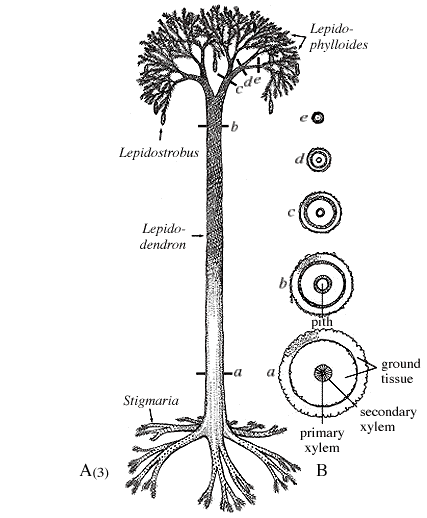| Lycopodiophyta | ||
| Plants | Lepidodendrales |
| Paleozoic Plants | Plants | Plant Kingdom | |||
| Parent | Plants Links | Palaeontology | Timescale |
| Lycophyta Home | Drepanophycales | Protolepidodendrales | Lycopodiales | Selaginellales |
| Lepidodendrales | Miadesmiales | Pleuromeiales | Isoetales |
 Two Late Carboniferous Lepidodendrales.
Two Late Carboniferous Lepidodendrales.This extinct order of giant scale trees includes relatives of the modern quillworts Isoetes). These striking plants reached their greatest diversity and development in the tropical swamps of the Late Carboniferous, when they formed forests of trees 30 to 40 metres or more in height. some, like the Late Carboniferous Lepidocarpon, show elaborate dispersal adaptations that operated almost like seeds. The trunks of these trees were unlike those of modern trees which possess a trunk composed mainly of wood with a thin outer covering of bark. Lycopsids had only a thin central core of wood surrounded by a thick layer of tissue [see figure]. For this reason it has been suggested that the forests of the Carboniferous swamps could have been easily flattened by high winds and storms.

The fossilized stems or trunks are notable for their scale-like bark which show a characteristic external pattern formed by the leaf-scars, showing a distinctive diamond-shaped pattern.

Lepidodendron and similar great trees grew in the hot humid swampland of the Carboniferous period. It possessed branching rooting organs, called Stigmaria, by which it was anchored in shallow soil. The Stigmaria had spirally arranged roots coming from them. Attached to the Stigmaria of Lepidodendron was a long pole-like trunk which had no branches for most of its length. The trunk terminated in a crown of simple branches which were covered with spirally arranged grass-like leaves, called Lepidophyllum. At the end of the branches were cigar-shaped reproductive cones, called Lepidostrobus, which contained spores. These different names (called "form genera") have been applied to different parts of Lepidodendron because they were originally discovered and scientifically described as separate parts. It was only later when more complete specimens were found that it was realized that the separately described parts in fact belonged to the same plant). In some cases the form genus turns out to belong to different families when the complete plant is considered. For example Stigmaria may belong to genera assigned to Lepidodendraceae, Sigillariaceae, or Lepidocarpaceae
Many of the larger lepidodendrid trees had monosporangiate cones, with highly specialized megasporangia that mimic the seed habit. A good example is Lepidocarpon. In Lepidocarpon cones, there is a single megaspore present that remains within the megasporangium, and the megasporangium remains tucked inside a leafy sporophyll that encloses it. The entire cone breaks up and these units thus serve as propagules. Because plants bearing this type of cone were living in a wet coal swamp, some paleobotanists have suggested that this dispersal unit acted as a small boat capable of aquatic dispersal.
The Lepidodendrales were the most elaborate and diversified of al the lycopsids, and dominated the Carboniferous, but with the drying of the climate during the latest Carboniferous and early Permian they went into a steep decline. By the middle Permian, they were all gone. Inefficient movement of water and nutrients through the stems of these tall plants, resulting from a lack of secondary xylem is cited as one of the reasons for their extinction.

Bateman RM, DiMichele WA & Willard DA (1992) Experimental cladistic analysis of anatomically preserved arborescent lycopsids from the Carboniferous of Euramerica: an essay on paleobotanical phylogenetics. Ann. Miss. Bot. Gard. 79, 500-559.
![]() see also general links section for more (almost all these pages will have info on Lepidondendrales)
see also general links section for more (almost all these pages will have info on Lepidondendrales)